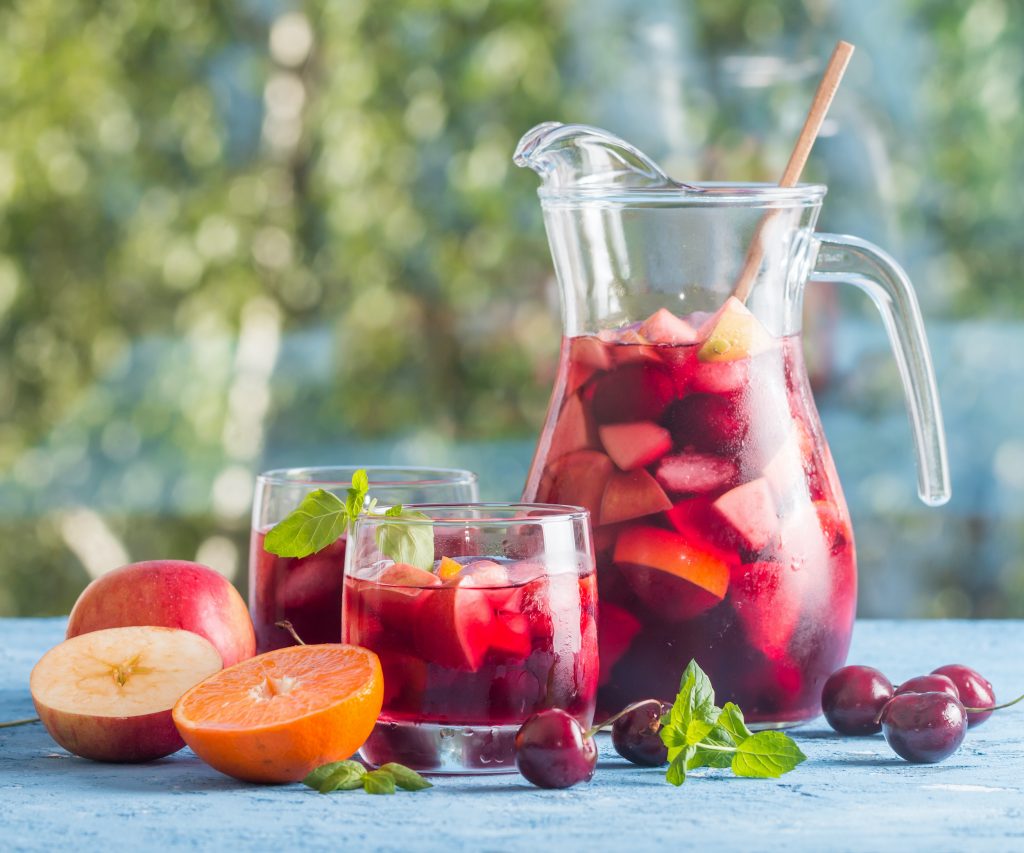
Spanish Sangria Original Recipe
If you’re looking for the BEST sangria recipe, you are in the right place: sangria is a staple in our home, something we enjoy making in summer when we have friends over but also when we just want to bring a bit of happiness in our place.
When you visit Spain it’s hard not to fall in love with sangria; despite being one of the most touristy things, sangria is also one of the most recognizable symbols of the country, and its fame is known all over the world.

So if you’re looking for the easiest and the best sangria recipe, we got you covered: not only this sangria is made with the traditional Spanish recipe, but it’s also quick and straightforward. Hard not to keep making it at home.
Keep reading for the recipe and scroll down if you want to know more about this Spanish drink, its variations, tips, and tricks for the perfect Spanish sangria.
Ingredients for for 1.5 lt of sangria
- 1 liter of red wine
- 2 oranges juiced
- 4 peaches
- 5 tablespoons of sugar
- 1 cinnamon stick
- The peel of 2 lemons
Instructions
- Pour the wine into a large bowl or in a tall jug and add sugar. Stir until sugar does dissolve;
- Add the juice of the two oranges and, if desired, also some slice of orange. Mix well;
- Cut the peaches into small pieces and add them to the mix, always stirring. Add the cinnamon stick and continue mixing;
- Put the jug in the fridge and pull out only when serving.
notes
Preparation time: 10 minutes
Cooking time: 0 minutes
Total time: 10 minutes

What is sangria?
Sangria is an alcoholic drink originating from Spain. It’s made with red wine, chopped fruits, and fresh orange juice. Nowadays, it is not rare to find versions of the drink made with white wine, sparkling water, and even brandy or whiskey.
What does sangria means?
The name Sangria comes from the Spanish sangres, bleeding, and the wine that is used is usually the Sangre de toro: it can be entirely substituted with Cabernet and Merlot or with the excellent and Spanish Rioja. According to the most accredited theories, sangria was born in the 9th Century, thanks to the Spanish peasants. They started to prepare a drink by using the products they had available at the moment, namely wine, peaches, apples, and citrus fruits. There are also other theories, but the substance is that today there are many types of sangria, and every person in Spain claims that it is the original recipe. At the base, however, there is always the stained wine, full red wine, although, in Catalunya, they prefer white wine.
Sangria variations
We’re not very keen on variations of traditional recipes, but sangria can be customized based on your taste and the fruit available. If you decide to customize this sangria, remember it’s not a sangria anymore: it’s a sangria-style kind of drink, not a real sangria. Anyway, these are some of the variations to the traditional sangria you can make at home, merely changing the fruit you use:
- strawberries
- plums
- pears
- apricots
- kiwis
just to name a few.
What red wine do you have to use for your sangria?
Wine is essential to get a great sangria, so don’t go on the cheap side, or your final result will suffer because of this. We recommend using a Spanish red wine like a Tempranillo or a Rioja to get the best result ever: both these red wines are fruity and work well with the fruit for a perfectly balanced sangria.
Can you use bottled orange juice for your sangria?
Traditionally, freshly squeezed orange juice is used. More modern versions of the drink are made with bottled orange juice, but the result can significantly change. If you have to use bottled orange juice, make sure it is of high standard and quality. Sangria requires the best ingredients you can find, and if you sacrifice them, the final result will be affected.

Best Sangria Recipe: Tips and Tricks
- To lower the amount of alcohol, just add some ice cube and lemon slices.
- If you want to raise the level of alcohol, you can add a couple of shots of rum.
- Cinnamon powder has to be avoided because it fails to blend well and remains on the surface even if mixed continuously. If you do not have cinnamon, replace it with cloves.
- Make your sangria in advance and let it rest in its pitcher for 2 to 8 hours for a maximum fruity flavor.
- Use a pitcher for your sangria to distribute the flavor evenly.






